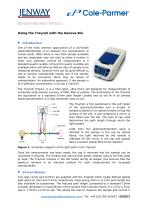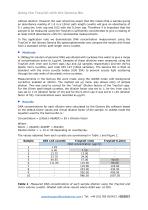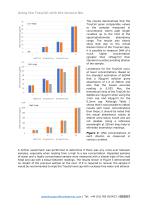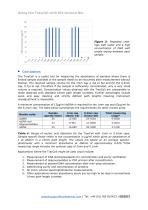
Excertos do catálogo

GENOVA BIO AND TRAYCELL Using the Traycell with the Genova Bio One of the most common applications of a UV/Visible spectrophotometer is to measure the concentration of nucleic acids. Often there is very little sample available and the researcher may not wish to dilute it further in order give sufficient volume for measurement in a standard quartz cuvette. Ultra-micro quartz cuvettes are available which will allow as little as 20µl of sample to be measured directly, however they can be quite difficult to use to achieve reproducible results and if the sample needs to be recovered, there may be issues of contamination. An alternative approach, if the sample is of a sufficient concentration, is to use a TrayCell. The TrayCell (Figure 1) is a fibre-optic, ultra-micro cell designed for measurements of extremely small sample volumes of DNA, RNA or protein. The dimensions of the TrayCell are equivalent to a standard 10mm path length cuvette and so will fit in all Jenway spectrophotometers; it is also extremely easy to use. The TrayCell is first positioned in the cell holder of the spectrophotometer and a droplet of sample is placed on an optical window on top the surface of the cell. A cap containing a mirror is then fitted over the top. The type of cap used determines the path length through which the light passes. Light from the spectrophotometer lamp is directed to the sample in the cap by optical fibres; the light returned by the sample is reflected off the mirror in the cap and passed down a second optical fibre to the detector. Figure 1: Schematic diagram of the light path in the TrayCell. Once the measurement has been made, the cap is removed and the sample can be recovered if required. The window and cap are then gently cleaned using a lint-free swab or wipe. The TrayCell remains in the cell holder during all stages; this ensures that the aperture remains in an identical position for each measurement for increased reproducibility. Virtual dilution Two caps (1mm and 0.2mm) are supplied with the TrayCell which create defined optical light paths of 1mm and 0.2mm respectively. Caps giving 2mm or 0.1mm path length are also available as accessories. The reduced path length (compared to a standard 10mm cuvette) generates a virtual dilution of the sample with a dilution factor of 1:10 for a 1mm cap or 1:50 for a 0.2mm cap. This allows the user to measure the sample and recover it cptechsupport@coleparmer.com | Tel: +44 (0)1785 810433 | 08/20
Abrir o catálogo na página 1
Using the TrayCell with the Genova Bio without dilution. However the user should be aware that this means that a sample giving an absorbance reading of 1.0 in a 10mm path length cuvette will give an absorbance of 0.1 using the 1mm cap and 0.02 with the 0.2mm cap. Therefore it is important that the sample to be measured using the TrayCell is sufficiently concentrated to give a reading of at least 0.025 absorbance units for reproducible measurements. In this application note we demonstrate DNA concentration measurement using the TrayCell in the Jenway Genova Bio spectrophotometer and compare...
Abrir o catálogo na página 2
Using the TrayCell with the Genova Bio The results demonstrate that the TrayCell gives comparable values to the samples measured in conventional 10mm path length cuvettes up to the limit of the spectrophotometer absorbance range. The results also clearly show that due to the virtual dilution factor of the TrayCell caps, it is possible to measure DNA of a much higher concentration (greater than 125µg/ml) than standard cuvettes avoiding dilution of the sample. Limitations for the TrayCell occur at lower concentrations. Based on the standard estimation of dsDNA that a 50µg/ml solution gives...
Abrir o catálogo na página 3
Using the TrayCell with the Genova Bio Figure 3: Repeated readings with water and a high concentration of DNA with simple wiping between each sample. The TrayCell is a useful tool for measuring the absorbance of samples where there is limited sample available or the sample needs to be recovered after measurement without dilution. The required sample volume for the 1mm cap is 3µl to 5µl and for the 0.2mm cap, 0.7µl to 4µl. Therefore if the sample is sufficiently concentrated, only a very small volume is required. Concentration values obtained with the TrayCell are comparable to those...
Abrir o catálogo na página 4Todos os catálogos e folhetos técnicos Jenway
-
Spectrophotometer Model Genova Bio
88 Páginas
-
72 Series Spectrophotometers 2017
8 Páginas
-
Masterflex®
2 Páginas
-
L/S® Digital Drives
2 Páginas
-
pH Buffers
1 Páginas
-
Bench pH Meter Accessories
5 Páginas
-
pH Electrodes
5 Páginas
-
3520
1 Páginas
-
3510
1 Páginas
-
Fluorimetry Cuvettes
1 Páginas
-
Fluorimeter Filters
1 Páginas
-
62 Series Fluorimeters
8 Páginas
-
PFP7/C Research Flame Photometer
1 Páginas
-
PFP7 Industrial Flame Photometer
2 Páginas
-
Colorimeter Accessories
2 Páginas
-
6051 Bench Colorimeter
2 Páginas
-
Conductivity Bench Meter Accessories
2 Páginas
-
Conductivity Standards
2 Páginas
-
Dissolved Oxygen (DO2) Probes
2 Páginas
-
9500 Bench DO2 Meter
1 Páginas
-
Spectrophotometer Summary
2 Páginas
-
Genova Plus Brochure
4 Páginas
-
Spectrophotometer Accessory Brochure
4 Páginas
-
72 Series Spectrophotometers
8 Páginas
-
73 Series Spectrophotometers
8 Páginas
-
Jenway Catalogue 2009
97 Páginas
-
63 Series Spectrophotometers
4 Páginas
-
Flame Photometers
2 Páginas
-
6051 Colorimeter
2 Páginas
-
Jenway Catalogue 2012
104 Páginas
-
Genova Plus
4 Páginas
-
Genova Nano
4 Páginas
-
PFP7
1 Páginas
-
6850 Spectrophotometer
4 Páginas
-
73 Series Brochure
8 Páginas
-
PFP7/C
1 Páginas
-
7300 Visible Spectrophotometer
1 Páginas
-
7305
1 Páginas
-
6305
1 Páginas
-
6300 and 6320D
1 Páginas
-
9500
1 Páginas
-
3505
1 Páginas
-
4520
1 Páginas
-
4510
1 Páginas
-
430 Conductivity/pH Meter
1 Páginas
Catálogos arquivados
-
6800 Spectrophotometer
2 Páginas
-
67 Series Spectrophotometers
8 Páginas
-
970
1 Páginas
-
3345 Bench Ion Mete
1 Páginas
-
3205 Portable Ion/pH Meter
1 Páginas
-
470 Conductivity/TDS Meter
1 Páginas
-
6051
2 Páginas
-
6 2 Series Fluorimeters
8 Páginas
































































